trailer Hyundai Azera 2005 Owner's Manual
[x] Cancel search | Manufacturer: HYUNDAI, Model Year: 2005, Model line: Azera, Model: Hyundai Azera 2005Pages: 297, PDF Size: 13.2 MB
Page 20 of 297
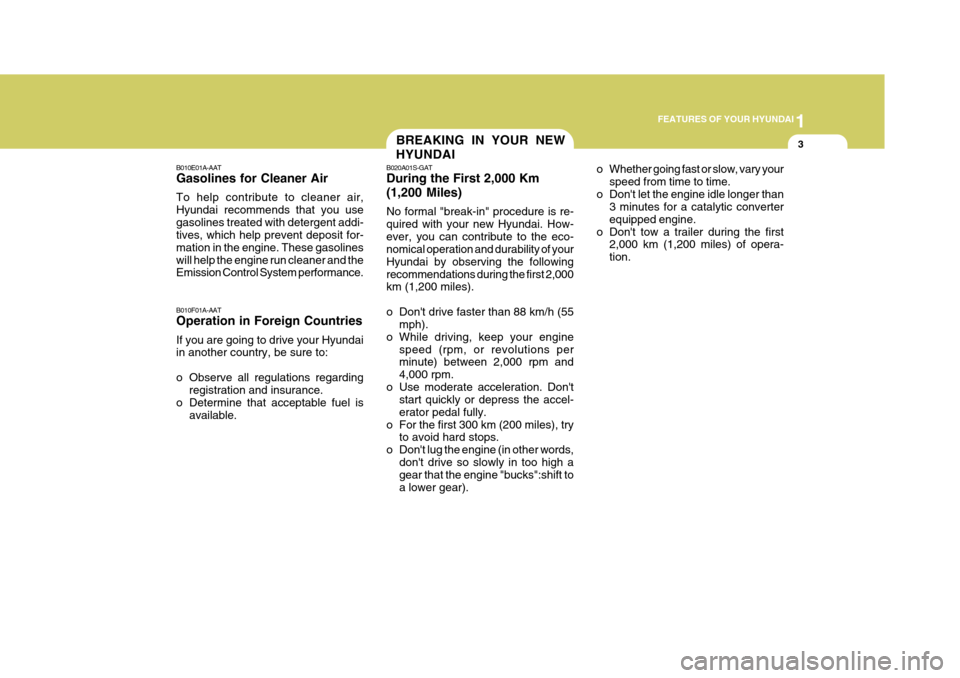
1
FEATURES OF YOUR HYUNDAI
3BREAKING IN YOUR NEW HYUNDAI
B010E01A-AAT Gasolines for Cleaner Air To help contribute to cleaner air, Hyundai recommends that you usegasolines treated with detergent addi- tives, which help prevent deposit for- mation in the engine. These gasolineswill help the engine run cleaner and the Emission Control System performance. B010F01A-AAT Operation in Foreign Countries If you are going to drive your Hyundai in another country, be sure to:
o Observe all regulations regarding
registration and insurance.
o Determine that acceptable fuel is
available. B020A01S-GAT During the First 2,000 Km (1,200 Miles) No formal "break-in" procedure is re- quired with your new Hyundai. How-ever, you can contribute to the eco- nomical operation and durability of your Hyundai by observing the followingrecommendations during the first 2,000 km (1,200 miles).
o Don't drive faster than 88 km/h (55
mph).
o While driving, keep your engine speed (rpm, or revolutions per minute) between 2,000 rpm and 4,000 rpm.
o Use moderate acceleration. Don't start quickly or depress the accel-erator pedal fully.
o For the first 300 km (200 miles), try to avoid hard stops.
o Don't lug the engine (in other words, don't drive so slowly in too high a gear that the engine "bucks":shift to a lower gear). o Whether going fast or slow, vary your
speed from time to time.
o Don't let the engine idle longer than 3 minutes for a catalytic converterequipped engine.
o Don't tow a trailer during the first 2,000 km (1,200 miles) of opera-tion.
Page 100 of 297
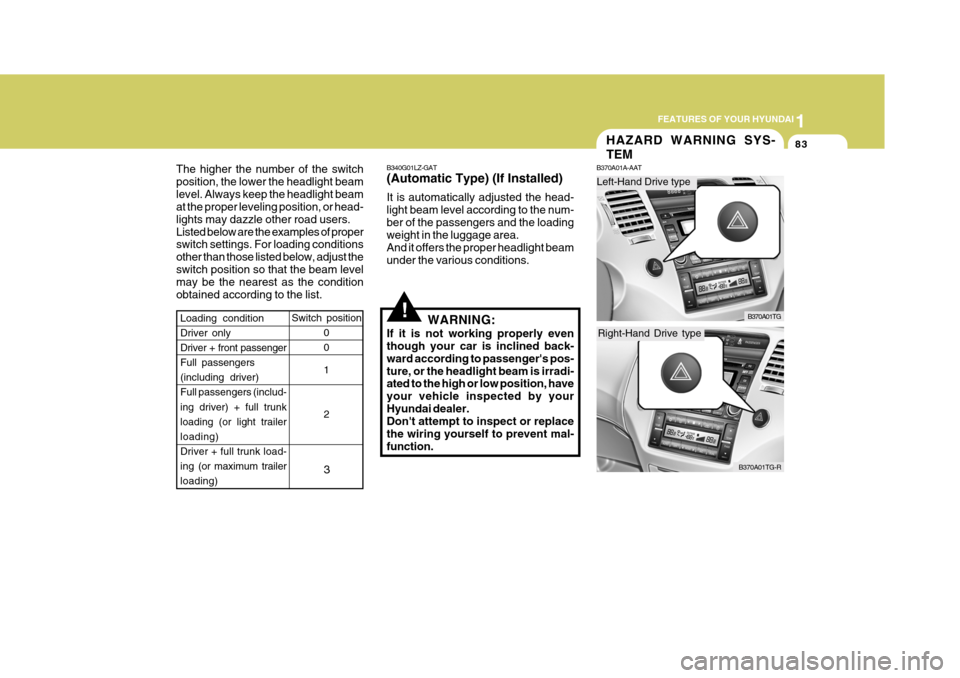
1
FEATURES OF YOUR HYUNDAI
83
Left-Hand Drive type
HAZARD WARNING SYS- TEM
B370A01A-AAT
B370A01TG
B370A01TG-R
Right-Hand Drive type
Switch position
0 0 1 2 3
Loading condition Driver onlyDriver + front passenger Full passengers (including driver)Full passengers (includ- ing driver) + full trunk loading (or light trailerloading)
Driver + full trunk load- ing (or maximum trailer
loading)
The higher the number of the switch position, the lower the headlight beamlevel. Always keep the headlight beam at the proper leveling position, or head- lights may dazzle other road users.Listed below are the examples of proper switch settings. For loading conditions other than those listed below, adjust theswitch position so that the beam level may be the nearest as the condition obtained according to the list.
!
B340G01LZ-GAT (Automatic Type) (If Installed) It is automatically adjusted the head- light beam level according to the num-ber of the passengers and the loading weight in the luggage area. And it offers the proper headlight beamunder the various conditions.
WARNING:
If it is not working properly even though your car is inclined back- ward according to passenger's pos-ture, or the headlight beam is irradi- ated to the high or low position, have your vehicle inspected by yourHyundai dealer. Don't attempt to inspect or replace the wiring yourself to prevent mal-function.
Page 185 of 297
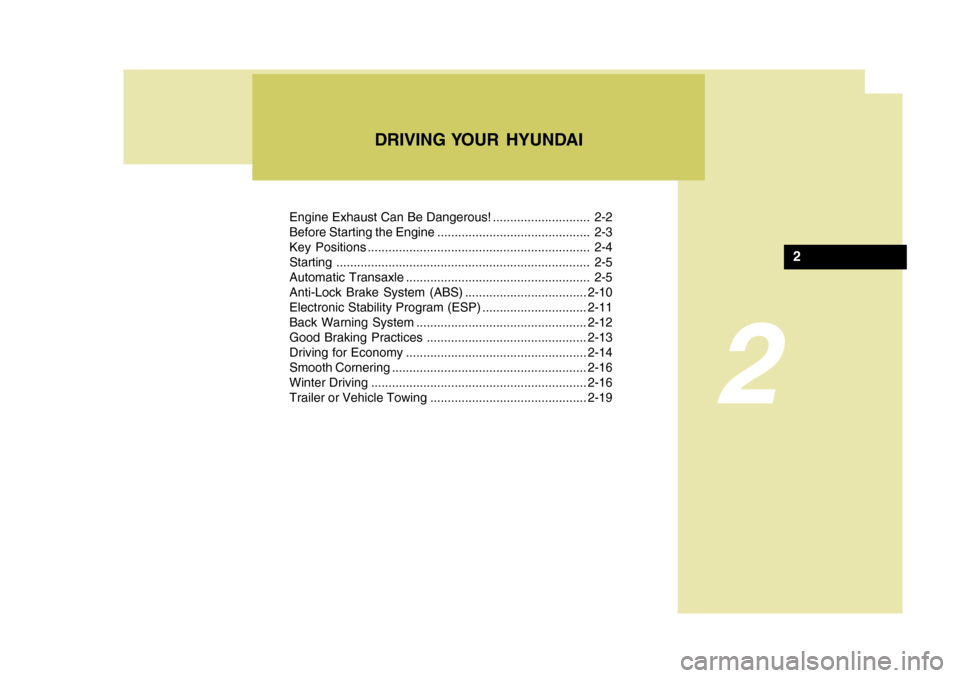
2
Engine Exhaust Can Be Dangerous! ............................ 2-2
Before Starting the Engine ............................................ 2-3
Key Positions ................................................................ 2-4Starting ......................................................................... 2-5
Automatic Transaxle ..................................................... 2-5Anti-Lock Brake System (ABS) ................................... 2-10
Electronic Stability Program (ESP) ..............................2-11
Back Warning System ................................................. 2-12
Good Braking Practices .............................................. 2-13
Driving for Economy .................................................... 2-14
Smooth Cornering ........................................................ 2-16
Winter Driving .............................................................. 2-16
Trailer or Vehicle Towing ............................................. 2-19
DRIVING YOUR HYUNDAI
2
Page 203 of 297

2
DRIVING YOUR HYUNDAI
19USE OF LIGHTSTRAILER OR VEHICLE TOWING
C190A01A-GAT If you are considering towing with your car, you should first check with your Province Department of Motor Vehicles to determine their legal requirements.Since laws vary from province to prov- ince the requirements for towing trail- ers, cars, or other types of vehicles orapparatus may differ. Ask your Hyundai dealer for further details before towing.
CAUTION:
Do not do any towing with your carduring its first 2,000 km (1,200 miles) in order to allow the engine to prop-erly break in. Failure to heed this caution may result in serious en- gine or transaxle damage.
!
C180A01A-AAT Check your lights regularly for correct operation and always keep them clean. When driving during the day in condi- tions of poor visibility, it is helpful todrive with headlights on low beam. This enables you to be seen as well as to see.
C190B01S-AAT Trailer Hitches Select the proper hitch and ball combi- nation, making sure that it's location iscompatible with that of the trailer or vehicle being towed. Use a quality non-equalizing hitch whichdistributes the tongue load uniformly throughout the chassis. The hitch should be bolted securely to the car and installed by a qualified technician. DO NOT USE A HITCHDESIGNED FOR TEMPORARY IN- STALLATION AND NEVER USE ONE THAT ATTACHES ONLY TO THEBUMPER. C190C02Y-GAT Trailer Brakes If your trailer is equipped with a braking system, make sure it conforms to fed-eral and/or local regulations and that it is properly installed and operating cor- rectly.
Page 204 of 297
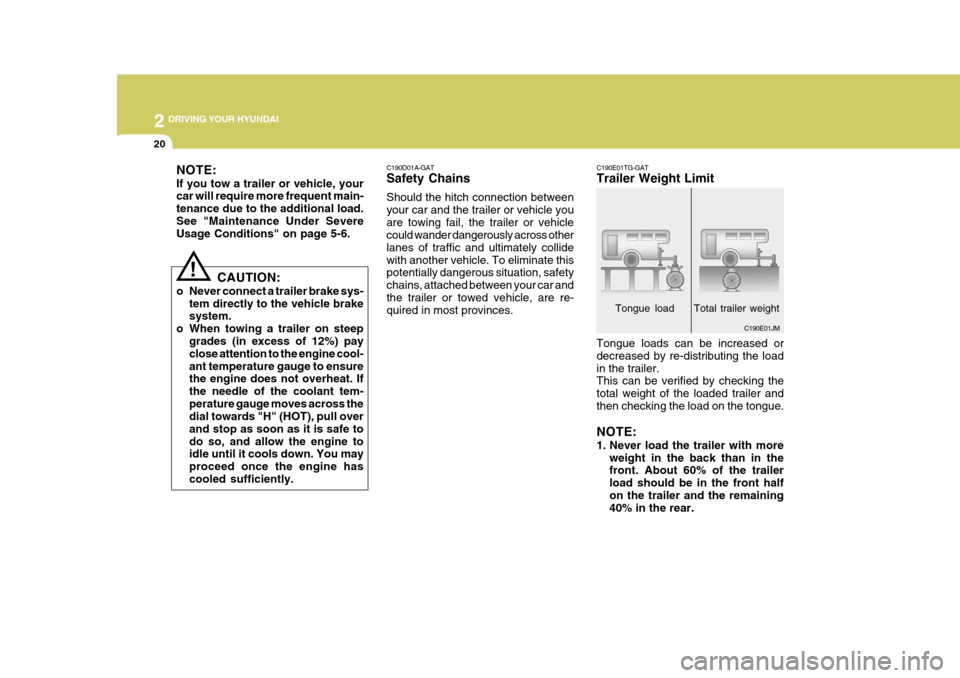
2 DRIVING YOUR HYUNDAI
20
NOTE: If you tow a trailer or vehicle, your car will require more frequent main- tenance due to the additional load.See "Maintenance Under Severe Usage Conditions" on page 5-6.
CAUTION:
o Never connect a trailer brake sys- tem directly to the vehicle brakesystem.
o When towing a trailer on steep grades (in excess of 12%) pay close attention to the engine cool-ant temperature gauge to ensure the engine does not overheat. If the needle of the coolant tem-perature gauge moves across the dial towards "H" (HOT), pull over and stop as soon as it is safe todo so, and allow the engine to idle until it cools down. You may proceed once the engine hascooled sufficiently.
! C190D01A-GAT Safety Chains Should the hitch connection between your car and the trailer or vehicle youare towing fail, the trailer or vehicle could wander dangerously across other lanes of traffic and ultimately collidewith another vehicle. To eliminate this potentially dangerous situation, safety chains, attached between your car andthe trailer or towed vehicle, are re- quired in most provinces.
C190E01TG-GAT Trailer Weight Limit
Tongue load Total trailer weight
Tongue loads can be increased or decreased by re-distributing the loadin the trailer. This can be verified by checking the total weight of the loaded trailer andthen checking the load on the tongue. NOTE:
1. Never load the trailer with more weight in the back than in the front. About 60% of the trailer load should be in the front halfon the trailer and the remaining 40% in the rear. C190E01JM
Page 205 of 297

2
DRIVING YOUR HYUNDAI
21
!
C190E02JM Improper trailer loading and/or too much luggage in the trunk canoverload the rear axle. Redistrib- ute the load and check the axle weight again.
4. The maximum permissible static vertical load on the coupling de-vice is 90 kg.
Gross Axle Weight Gross Vehicle
Weight
2. The total gross vehicle weight with trailer must not exceed the GrossVehicle Weight Rating (GVWR)shown on the vehicle identifica- tion plate (see page 8-2). The total gross vehicle weight is the com-bined weight of the vehicle, driver, all passengers and their luggage, cargo, hitch, trailer tongue loadand other optional equipment.
3. The front or rear axle weight must
not exceed the Gross Axle WeightRating (GAWR) shown on the vehicle identification plate (see page 8-2). It is possible that yourtowing package does not exceed the GVWR but exceeds the GAWR. C190E01TGkg (lbs)
CAUTION:
The following specifications are rec- ommended when towing a trailer.The loaded trailer weight cannot safely exceed the values in the chart below.
!
WARNING:
Improperly loading your car and trailer can seriously affect its steer-ing and braking performance caus- ing a crash which could cause injury or death.
Tongue
90 (198) -
With Brake Without Brake Maximum Towable Weight
Trailer
1800 (3968) 750 (1653)
5. The maximum permissible over- hang of the coupling point is 1,255 mm. Coupling point
Page 206 of 297
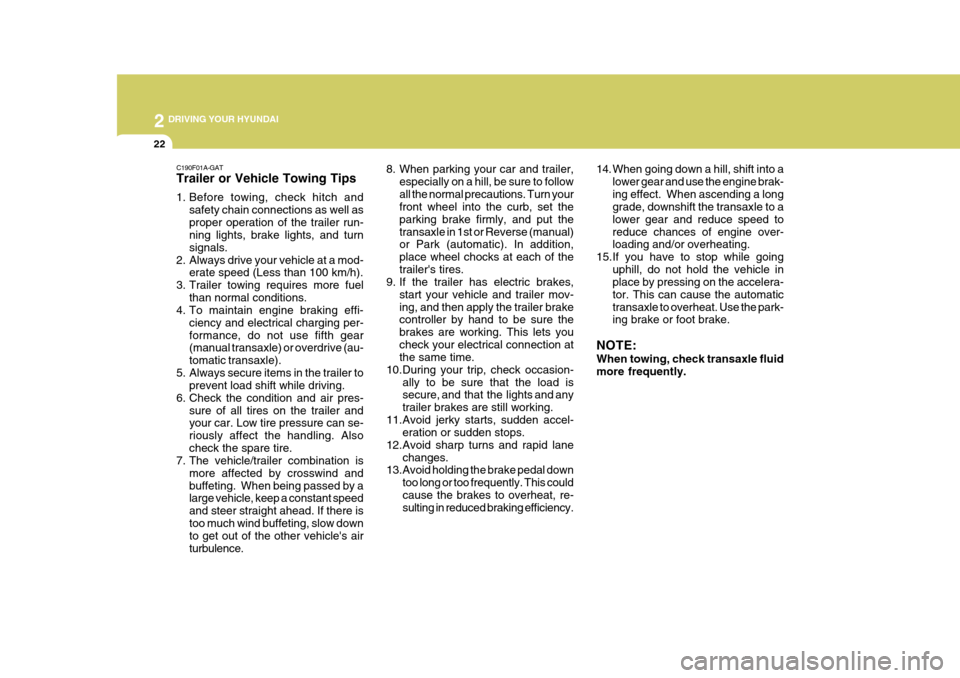
2 DRIVING YOUR HYUNDAI
22
C190F01A-GAT Trailer or Vehicle Towing Tips
1. Before towing, check hitch andsafety chain connections as well as proper operation of the trailer run- ning lights, brake lights, and turn signals.
2. Always drive your vehicle at a mod- erate speed (Less than 100 km/h).
3. Trailer towing requires more fuel than normal conditions.
4. To maintain engine braking effi-
ciency and electrical charging per-formance, do not use fifth gear (manual transaxle) or overdrive (au- tomatic transaxle).
5. Always secure items in the trailer to prevent load shift while driving.
6. Check the condition and air pres- sure of all tires on the trailer and your car. Low tire pressure can se- riously affect the handling. Alsocheck the spare tire.
7. The vehicle/trailer combination is
more affected by crosswind andbuffeting. When being passed by a large vehicle, keep a constant speed and steer straight ahead. If there istoo much wind buffeting, slow down to get out of the other vehicle's air turbulence. 8. When parking your car and trailer,
especially on a hill, be sure to followall the normal precautions. Turn your front wheel into the curb, set the parking brake firmly, and put thetransaxle in 1st or Reverse (manual) or Park (automatic). In addition, place wheel chocks at each of thetrailer's tires.
9. If the trailer has electric brakes,
start your vehicle and trailer mov-ing, and then apply the trailer brake controller by hand to be sure the brakes are working. This lets youcheck your electrical connection at the same time.
10.During your trip, check occasion- ally to be sure that the load issecure, and that the lights and any trailer brakes are still working.
11.Avoid jerky starts, sudden accel- eration or sudden stops.
12.Avoid sharp turns and rapid lane changes.
13.Avoid holding the brake pedal down
too long or too frequently. This couldcause the brakes to overheat, re- sulting in reduced braking efficiency. 14. When going down a hill, shift into a
lower gear and use the engine brak- ing effect. When ascending a long grade, downshift the transaxle to a lower gear and reduce speed toreduce chances of engine over- loading and/or overheating.
15.If you have to stop while going uphill, do not hold the vehicle inplace by pressing on the accelera- tor. This can cause the automatictransaxle to overheat. Use the park- ing brake or foot brake.
NOTE: When towing, check transaxle fluid more frequently.
Page 233 of 297
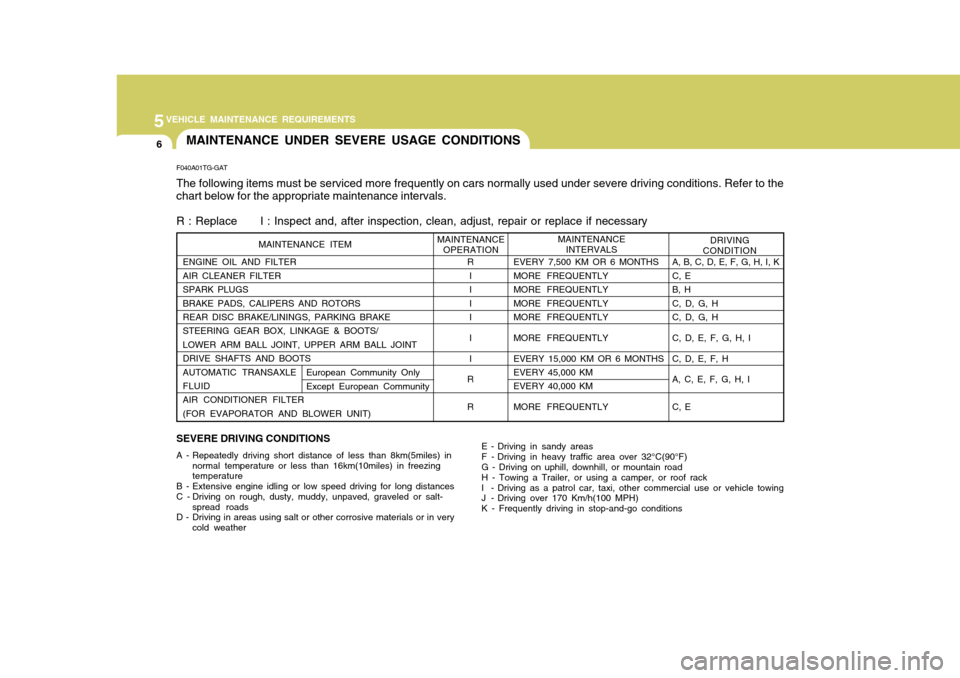
5VEHICLE MAINTENANCE REQUIREMENTS
6
F040A01TG-GAT The following items must be serviced more frequently on cars normally used under severe driving conditions. Refer to the chart below for the appropriate maintenance intervals. R : Replace I : Inspect and, after inspection, clean, adjust, repair or replace if necessaryMAINTENANCE UNDER SEVERE USAGE CONDITIONS
ENGINE OIL AND FILTER AIR CLEANER FILTERSPARK PLUGSBRAKE PADS, CALIPERS AND ROTORSREAR DISC BRAKE/LININGS, PARKING BRAKE STEERING GEAR BOX, LINKAGE & BOOTS/ LOWER ARM BALL JOINT, UPPER ARM BALL JOINTDRIVE SHAFTS AND BOOTSAUTOMATIC TRANSAXLEFLUID AIR CONDITIONER FILTER
(FOR EVAPORATOR AND BLOWER UNIT)
R I III I I
R R A, B, C, D, E, F, G, H, I, K C, EB, HC, D, G, HC, D, G, H C, D, E, F, G, H, I C, D, E, F, H A, C, E, F, G, H, I C, E
MAINTENANCE ITEM
European Community Only Except European Community
DRIVING
CONDITION
MAINTENANCE
OPERATION
EVERY 7,500 KM OR 6 MONTHS MORE FREQUENTLYMORE FREQUENTLYMORE FREQUENTLYMORE FREQUENTLY MORE FREQUENTLY EVERY 15,000 KM OR 6 MONTHS EVERY 45,000 KM EVERY 40,000 KM MORE FREQUENTLYMAINTENANCE
INTERVALS
SEVERE DRIVING CONDITIONS
A - Repeatedly driving short distance of less than 8km(5miles) in normal temperature or less than 16km(10miles) in freezing temperature
B - Extensive engine idling or low speed driving for long distances
C - Driving on rough, dusty, muddy, unpaved, graveled or salt- spread roads
D - Driving in areas using salt or other corrosive materials or in very cold weather E - Driving in sandy areas
F - Driving in heavy traffic area over 32°C(90°F)G - Driving on uphill, downhill, or mountain roadH - Towing a Trailer, or using a camper, or roof rack
I - Driving as a patrol car, taxi, other commercial use or vehicle towing
J - Driving over 170 Km/h(100 MPH) K - Frequently driving in stop-and-go conditions
Page 296 of 297
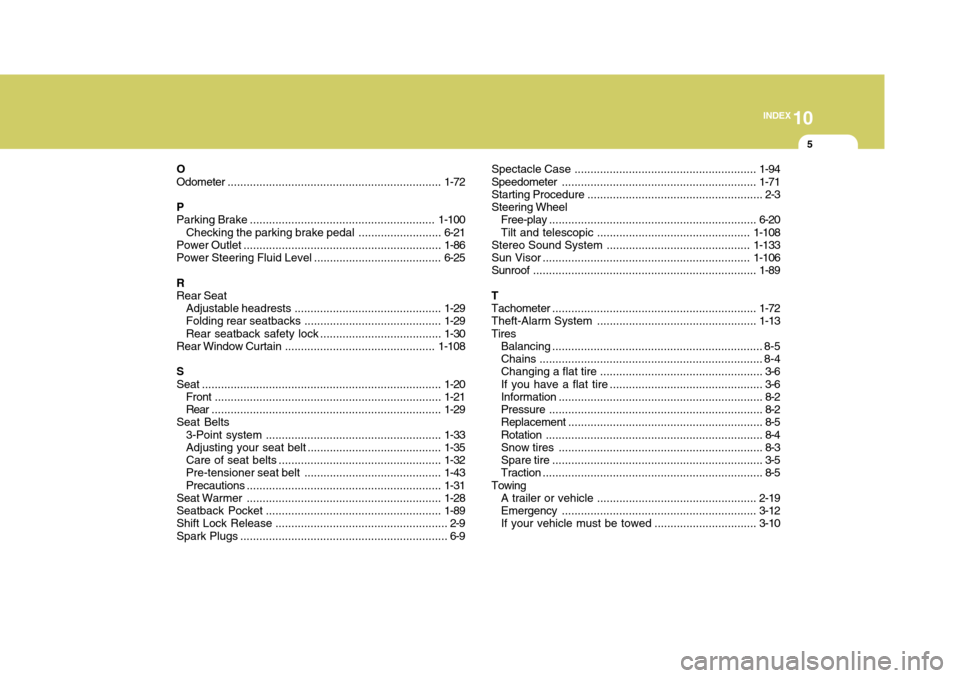
10
INDEX
5
O Odometer ................................................................... 1-72
P Parking Brake .......................................................... 1-100
Checking the parking brake pedal ..........................6-21
Power Outlet .............................................................. 1-86
Power Steering Fluid Level ........................................ 6-25
RRear Seat Adjustable headrests .............................................. 1-29
Folding rear seatbacks ........................................... 1-29
Rear seatback safety lock ...................................... 1-30
Rear Window Curtain ............................................... 1-108
S Seat ........................................................................... 1-20
Front ....................................................................... 1-21
Rear ........................................................................ 1-29
Seat Belts
3-Point system ....................................................... 1-33
Adjusting your seat belt .......................................... 1-35
Care of seat belts ................................................... 1-32
Pre-tensioner seat belt ........................................... 1-43
Precautions ............................................................. 1-31
Seat Warmer ............................................................. 1-28
Seatback Pocket ....................................................... 1-89
Shift Lock Release ...................................................... 2-9
Spark Plugs ................................................................. 6-9 Spectacle C
ase ......................................................... 1-94
Speedometer ............................................................. 1-71
Starting Procedure ....................................................... 2-3
Steering Wheel Free-play ................................................................. 6-20
Tilt and tel escopic ................................................ 1-108
Stereo Sound System ............................................. 1-133
Sun Visor ................................................................. 1-106
Sunroof ...................................................................... 1-89
TTachometer ................................................................ 1-72
Theft-Alarm System .................................................. 1-13
Tires Balancing .................................................................. 8-5
Chains ...................................................................... 8-4
Changing a flat tire ................................................... 3-6
If you have a flat tire ................................................ 3-6
Information ................................................................ 8-2
Pressure ................................................................... 8-2
Replacement ............................................................. 8-5
Rotation .................................................................... 8-4
Snow tires ................................................................ 8-3
Spare tire .................................................................. 3-5
Traction ..................................................................... 8-5
Towing A trailer or vehicle .................................................. 2-19
Emergency ............................................................. 3-12
If your vehicle must be towed ................................ 3-10